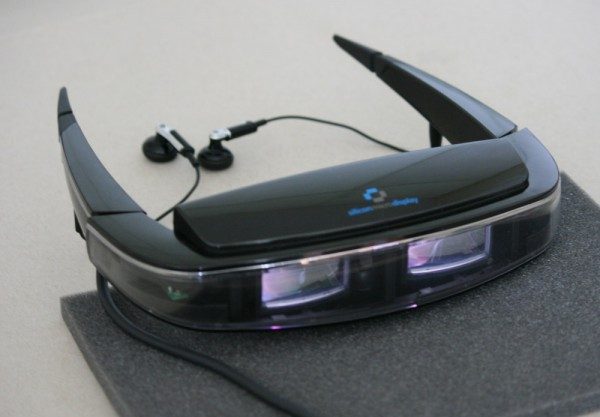
I spoke with Silicon Micro Display recently and they tell me that the scarcity of initial units has prevented them from getting the ST1080 out to major outlets for review just yet. That’s why we’ve thus far only seen user-impressions of SMD’s first head mounted display. We’ll see reviews from the big guys in the next few weeks most likely. Speaking of which, I’ve got another ST1080 user review to highlight.
Reader Ken commented on my post about the first ST1080 impressions and left a link to another user review of the ST1080 which appears to be from the Netherlands. Fortunately this one is much more readable than the last!
Jeffrey, who appears to be the author, now has part 1 and part 2 of ST1080 impressions posted. The review isn’t terrible detailed, but I’ll pull out some of the good bits for you.
According to the author, the ST1080 works well as a computer-monitor replacement, but there is some blur on text at the corners of the screen (as we have heard from others as well). This would be due to an ‘exit-pupil’ that isn’t all encompassing:
After 10 minutes and playing with the 2 pupil distance adjustment switches the screen was finally clear and good to read. I visited some websites and used some applications and this went all without problems. Just like looking at a normal screen. The text at the corners of the screen however stays a bit blurry.
He also comments on the quality of the display (not surprisingly, the blacks aren’t as dark as an OLED display) and points out some interesting RGB ghosting that is likely inherent to LCoS display technology:
The screens themselves are clear and in 1080p. The FOV is good. Black however isn’t truly black, but more like dark gray, like lcd screens. When moving your head quickly up and down the display technology shows his weak spot: All white colored text on the screen will leave a Red, Green and Blue trace. The displays work by quickly showing just one color at the time. But when using the HMD to watch movies and play games I never really noticed it so it won’t disturb any normal use with the ST1080. Another thing worth knowing is that this unit won’t block the light coming from the top of the bottom of the unit. You can just look down and see the floor, just like normal glasses.
The ST1080 again scores good points in the comfort and longevity department:
The included nose rubbers are also clearly not designed for my nose. The unit slides of my nose when looking down. There is however a cord included which you can use as a strap to attach the hmd to your head. With it, the hmd fits fine and is useable. It also puts less weight on your nose with it so don’t throw this cord away! There is no eye strain using this device. It didn’t hurt my head or made me disoriented. The comfort is not that great, since it still puts some weight on your nose. The unit however is light and you can easily use it for hours.
[after a week of use]: The comfort is good. I can use it for several hours without having any trouble at all. Haven’t got headaches and my eyes doesn’t hurt. The cord/strap to keep the unit in place is good and easily adjustable and the (thick but light) cable from the HMD to the control unit is not getting in the way while using the HMD.
There’s also some info regarding 3D videos and gaming. Jeffrey says he had to use some software from http://www.iz3d.com/ to get 3D gaming working on his computer with the ST1080:
The ST1080 supports lots of different video resolutions, both 2d as 3d. For 2d the highest resolution with the highest frames per second you can go is 1080p at 60Hz. For 3d it is 1080p at 30Hz (Top-and-bottom). When watching movies it is just great. 3D works beautiful. For 3d gaming 30Hz is a bit low and you’ll have to make a choice between high fps or high resolution. The ST1080 does offer you 60Hz at half resolution or at 720p. Almost all PS3 games with 3d support already switch to the 720p resolution where you can enjoy 3d gaming with full 60Hz. The ST1080 currently does not support scaling. This means using the 720p resolutions will reduce the screen size and FOV. SiliconMicroDisplay however announced that they will add scaling with a firmware update in the future.
Some of the games I played with this were Diablo 3, Trackmania Nations, Unreal Tournament 2004 and Test Drive Unlimited 2. The 3D effects in those games were amazing! I preferred the mode ’1080p @ 60Hz SBS Half resolution’. The screen is big and you can easily read and see everything while still having 60Hz. The ’pop out’ feeling with this HMD is great. I actually tried to move my head out of the way of a rocket in Unreal Tournament 2004 once. In 2D games are also great. The displays look like a large screen hanging at the other side of the room. It really makes you feel you are part of the game. Flying with the redeemer in unreal tournament is a total different experience now!
Silicon Micro Display has now launched a community forum for ST1080 users. Jeffrey says he is active there if anyone has further questions.
I’m hoping to receive an ST1080 for review in the next few weeks, stay tuned!






